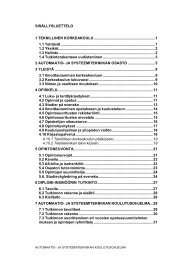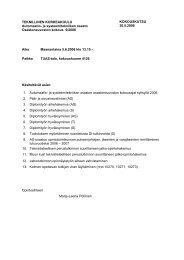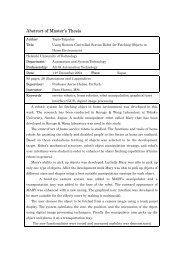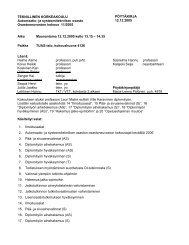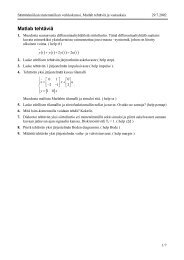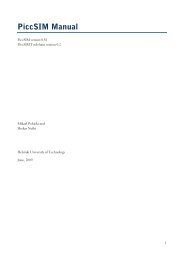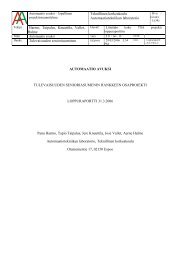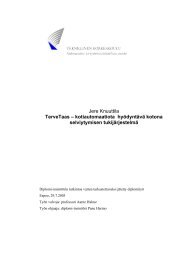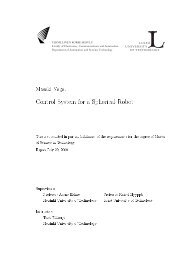fem modelling of a bellows and a bellows- based micromanipulator
fem modelling of a bellows and a bellows- based micromanipulator
fem modelling of a bellows and a bellows- based micromanipulator
Create successful ePaper yourself
Turn your PDF publications into a flip-book with our unique Google optimized e-Paper software.
FEM <strong>modelling</strong> <strong>of</strong> a <strong>bellows</strong> <strong>and</strong> a <strong>bellows</strong>-<strong>based</strong> <strong>micromanipulator</strong>II. Bellows' dimensionspixels <strong>of</strong> the pictures. Hence, a factor converting dimensions measured by numbering pixelsin millimetres is determined. One example is exhibited in figure 6. The conversion factorfrom pixels into millimetres is 49 – but not in this figure, that has been re-sized – <strong>and</strong> thepicture is orthogonal, i.e. the same factor suits for both x- <strong>and</strong> y-directions.2.3 Solid model2.3.1 CONSISTENT UNITSANSYS ® is an unitless program. This means that it does not take into account any units forthe parameters it calculates with. It is up to the operator to be consistent with the units heutilises. Therefore, one basis has to be chosen, <strong>and</strong> all units have to be adapted to it. TheI.U.S. 2 involves meters for length, kilograms for weight, seconds for time, amperes forcurrent, Kelvins for temperature, moles for substance quantity <strong>and</strong> c<strong>and</strong>elas for luminousintensity. With those seven units, it is possible to build all other, accordingly to theirdefinitions.2.3.2 UNITS CONVERSIONBecause <strong>of</strong> the <strong>bellows</strong>’ dimensions, millimetres are used for the geometrical description.Consequently, the unit basis will be the following (only these are needed):Length = [mm] Mass = [kg] Time = [s]Let’s now deduce from the I.U.S., the units <strong>of</strong> different parameters to be applied in thissimulation, such as velocity, acceleration, force, pressure, <strong>and</strong> density. The followingcalculations are shown, to make the reader attentive <strong>of</strong> the unit-problem:• 1 [m] = 1 [m] · [m/m] = 1 [m] · (10 3 [mm/m]) = 10 3 [m·mm/m] = 10 3 [mm] (3)• 1 [m/s] = 1 [m/s] · (10 3 [mm/m]) = 10 3 [mm/s]• 1 [m/s 2 ] = 1 [m/s 2 ] · (10 3 [mm/m]) = 10 3 [mm/s 2 ]• 1 [N] = 1 [m·kg/s 2 ] = 1 [m·kg/s 2 ] · (10 3 [mm/m]) = 10 3 [mm·kg/s 2 ] = 10 3 [mN]• 1 [N/m 2 ] = 1 [N/m 2 ] · (10 -3 [m/mm]) 2 = 10 -6 [N·m 2 /m 2·mm 2 ] = 10 -3 [mN/mm 2 ]• 1 [kg/m 3 ] = 1 [kg/m 3 ] · (10 -3 [m/mm]) 3 = 10 -9 [kg·m 3 /m 3·mm 3 ] = 10 -9 [kg/mm 3 ]The following conversion table can be given:{ [m] ; [kg] ; [s] } { [mm] ; [kg] ; [s] }Length 1 [m] = 10 3 [mm]Velocity 1 [m/s] = 10 3 [mm/s]Acceleration 1 [m/s 2 ] = 10 3 [mm/s 2 ]Force 1 [N] = 10 3 [mN]Pressure 1 [Pa] = [N/m 2 ] = 10 -3 [kPa] = 10 -3 [mN/mm 2 ]Density 1 [kg/m 3 ] = 10 -9 [kg/mm 3 ]2 International Units System3 This result is evident, but shows the correct method which should be applied for all other units.9



